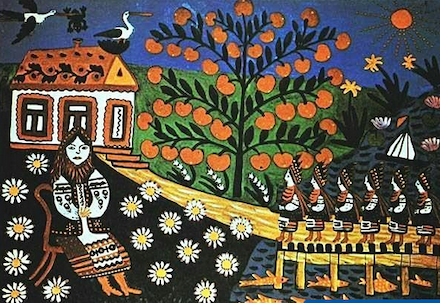
|
|
|
|
|
| Issue 15: | Sept. 2022 |
| Haibun: | 124 words |
By Margaret Dornaus
When a Tree Falls
for Maria Prymachenko (c. 1908–1997)
Does it cry out? in desperation? Can you hear it? if you’ve never walked the forest path arm-in-arm beside me? If you’re not standing there before it? if you don’t know every plant its branches sheltered—three-petaled trillium, five-fingered maidenhair, Saint-John’s-wort—by name and number?
Do you remember that day life changed? The day I noticed how earthbound roots held my world together. The day I knelt to pocket handfuls of fresh dirt mixed with lichen inside my apron as if I was exhuming buried treasure. That day I transformed childhood landscapes into paintings Picasso would call miracles.
en plein air ...
the steady thrum of bees
and balalaikas

Years of My Youth, Come Visit Me (1969) By Maria Prymachenko*
Poets’ Note
I only learned of Maria Prymachenko’s extraordinary life and art a few months ago, after news that Russian forces had targeted a Ukrainian museum containing several dozens of the self-taught artist’s paintings. One of Ukraine’s most celebrated folk artists, Prymachenko completed hundreds of paintings that pay homage to the village life she knew and loved during her lifetime. That so many of Prymachenko’s paintings faced destruction due to Russia’s invasion of Ukraine led me to examine the significant role that she and other artists continue to play in shaping our views of the world.
* Publisher’s Notes:
1. Maria Prymachenko (c. 1908–18 August 1997) was a Ukrainian folk artist who worked in drawing, painting, embroidery, and ceramics. Her works are featured on Ukrainian stamps and coins, and more than 650 of her works are held in the collection of the National Folk Decorative Art Museum in Kyiv, capital of Ukraine (source: Wikipedia).
2. See also: Russian forces almost destroyed this Ukrainian artist’s work. Now it’s becoming a global symbol of peace, by Oscar Holland for CNN (9 March 2022).
And Katie White’s article at ArtNet (15 March 2022): Ukrainian Artist Maria Prymachenko’s Fantastical Visions Have Captivated the World—Here Are 3 Key Insights Into Her Life and Work; “An inspiration for Picasso and Chagall, her works are now an international symbol of the call for peace.”
Margaret Dornaus
holds an MFA in the translation of poetry from the University of Arkansas. A semi-finalist in Naugatuck River Review’s 13th annual Narrative Poetry Contest, she had the privilege of editing and publishing a pandemic-themed anthology, Behind the Mask: Haiku in the Time of Covid-19, through her small literary press, Singing Moon, and received a Best of the Net nomination in 2020.
Her first book of poetry, Prayer for the Dead: Collected Haibun & Tanka Prose, received a 2017 Merit Book Award from the Haiku Society of America. Recent poems appear in The Ekphrastic Review, Lindenwood Review, MockingHeart Review, and Red Earth Review, as well as in the tribute series for Lawrence Ferlinghetti, I Am Still Waiting, published by Silver Birch Press.
More on the Web: By, About, and Beyond
⚡ Le Rêve, ekphrastic haibun by Margaret Dornaus which was nominated by MacQ for the Red Moon Anthologies, and selected for publication in Contemporary Haibun 17 (Red Moon Press, 2022).
| Copyright © 2019-2025 by MacQueen’s Quinterly and by those whose works appear here. | |
| Logo and website designed and built by Clare MacQueen; copyrighted © 2019-2025. | |
|
Data collection, storage, assimilation, or interpretation of this publication, in whole or in part, for the purpose of AI training are expressly forbidden, no exceptions. |
At MacQ, we take your privacy seriously. We do not collect, sell, rent, or exchange your name and email address, or any other information about you, to third parties for marketing purposes. When you contact us, we will use your name and email address only in order to respond to your questions, comments, etc.